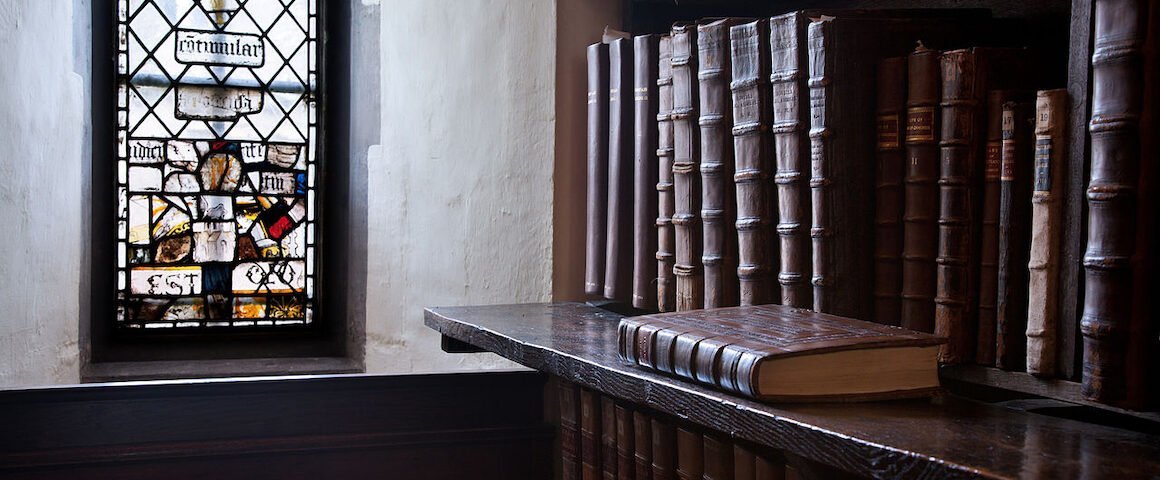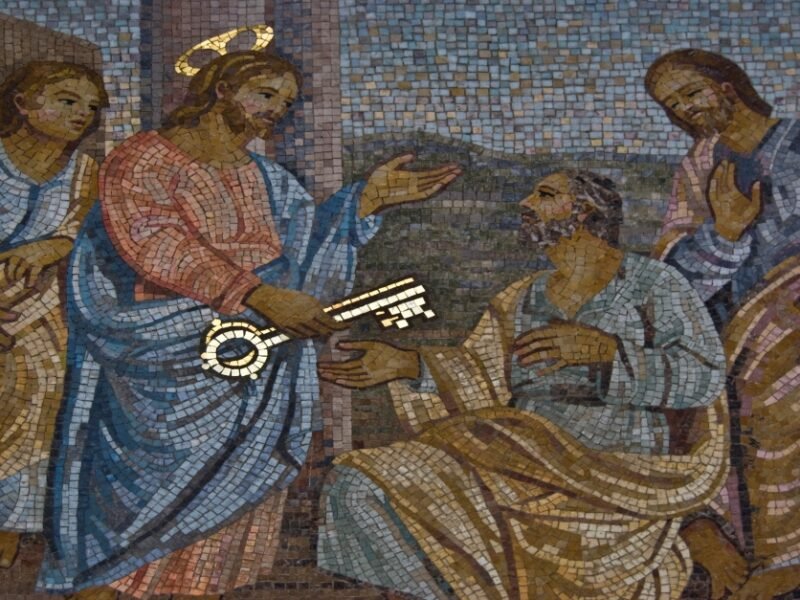It is a matter of historical fact—invoked by the Article and observed by Browne—that the early church conducted its public prayers in tongues “understanded of the people”:
Greek, Latin, and Syriac were languages spoken by the great bulk of the nations first converted to Christianity; and therefore the earliest liturgies and translations of the Scriptures were sure to be in these tongues. But moreover, the Egyptians, Ethiopians or Abyssinians, Muscovites, Armenians and others, had liturgies in the vernacular.
This has been acknowledged by Romanist scholars: “Eminent schoolmen and Roman Catholic divines, as Lyra, Thomas Aquinas and Harding, have fully allowed that in the primitive Church prayers were offered up in the vulgar tongue, that the people might be the better instructed.” Aquinas is quoted by Bishop Beveridge on this point as follows: “In the primitive church it was madness for any one to say prayers in an unknown tongue, because then they were ignorant of the ecclesiastical rites, and knew not what was done there.”[1] Nevertheless, as the centuries passed, the Church of Rome saw fit to codify the use of Latin in its liturgies as a binding norm on all the Christian world, to the point that in the Council of Trent, “it was forbidden by an anathema to say that the mass should not be celebrated in any but the vulgar tongue, or the consecration not performed in a low voice.”[2] In fact, the Article’s present wording is thought to be a response to this canon of Trent—previously the Article merely affirmed, “It is most fit and most agreeable to the Word of God that nothing be read or rehearsed in the Congregation in a tongue not known unto the people,”[3] whereas now it actively condemns the failure to use a tongue known to the people as “repugnant to the Word of God, and the custom of the Primitive Church.”[4] Browne notes that “in modern times some prayers are offered in the churches of the Roman communion in tongues understood of the people, yet the mass is never celebrated except in Latin.”
However, the Roman attitude toward vernacular liturgy has shifted dramatically since Browne’s time. At the Second Vatican Council, it was held that, “particular law remaining in force, the use of the Latin language is to be preserved in the Latin rites.”[5] Yet at the same time, it was granted that “since the use of the mother tongue, whether in the Mass, the administration of the sacraments, or other parts of the liturgy, frequently may be of great advantage to the people, the limits of its employment may be extended.”[6] Here an allowance was made for vernacular in the liturgy, including the mass, but the use of Latin was still normative. In the ensuing decades, though—after the Novus Ordo (also known as the Ordinary Form, or the Mass of Paul VI) was completed and promulgated as the standard Roman mass—it was the Tridentine Latin Mass (also known as the Traditional Latin Mass, or TLM) that was granted a special allowance. Pope John Paul II permitted its continued use so as to “facilitate…ecclesial communion” for “all those Catholic faithful who feel attached to some previous liturgical and disciplinary forms of the Latin tradition.”[7] Likewise, Pope Benedict XVI declared that it was “permitted to celebrate the Sacrifice of the Mass following the typical edition of the Roman Missal, which was promulgated by Blessed John XXIII in 1962 and never abrogated, as an extraordinary form of the Church’s Liturgy.”[8] Now the latitude granted by these previous popes has to a great extent been withdrawn by Pope Francis, who, in order to “press on ever more in the constant search for ecclesial communion,” has imposed restrictions on the TLM, requiring that priests “who wish to celebrate using the Missale Romanum of 1962, should submit a formal request to the diocesan Bishop who shall consult the Apostolic See before granting this authorization.”[9] When Pope Francis later elaborated on this decision, he stated the following:
We cannot go back to that ritual form which the Council fathers, cum Petro et sub Petro, felt the need to reform, approving, under the guidance of the Holy Spirit and following their conscience as pastors, the principles from which was born the reform. The holy pontiffs St. Paul VI and St. John Paul II, approving the reformed liturgical books ex decreto Sacrosancti Œcumenici Concilii Vaticani II, have guaranteed the fidelity of the reform of the Council. For this reason I wrote Traditionis custodes, so that the Church may lift up, in the variety of so many languages, one and the same prayer capable of expressing her unity.[10]
The rationale for this trend in the Roman Church, as articulated at the Second Vatican Council, is that
The Church…earnestly desires that Christ’s faithful, when present at this mystery of faith [the Eucharist], should not be there as strangers or silent spectators; on the contrary, through a good understanding of the rites and prayers they should take part in the sacred action conscious of what they are doing, with devotion and full collaboration.[11]
This is precisely the reasoning expressed in one of the Anglican Homilies, some four hundred years prior, on why public prayer should be in the vernacular:
When prayers or administration of sacraments shall be in a tongue unknown to the hearers, which of them shall be thereby stirred up to lift up his mind to God and to beg with the minister at God’s hand those things which in the words of his prayers the minister asketh? Or who shall in the ministration of the sacraments understand what invisible grace is to be craved of the hearer, to be wrought in the inward man? Truly no man at all.[12]
Glad though we may be that the Church of Rome has become sounder on this point, its current practice stands in awkward relation to the Council of Trent. Unsurprisingly, contemporary Romanist authors have maintained that “the theological understanding of the liturgy in Sacrosanctum concilium…does not contradict that of Trent; rather, it situates Trent’s teaching on the sacraments in a broader context to enable a richer understanding of the mystery of God in Christ made present in the liturgy, and facilitate participation in it.”[13] The apparent basis for this claim is that the Council of Trent, while certainly predisposed against vernacular liturgy, technically did not prohibit it altogether. Part of the relevant decree states, “Although the mass contains great instruction for the faithful people, nevertheless, it has not seemed expedient to the Fathers, that it should be every where celebrated in the vulgar tongue.”[14] The corresponding canon reads similarly: “If any one saith, that the rite of the Roman Church, according to which a part of the canon and the words of consecration are pronounced in a low tone, is to be condemned; or, that the mass ought to be celebrated in the vulgar tongue only; or, that water ought not to be mixed with the wine that is to be offered in the chalice, for that it is contrary to the institution of Christ; let him be anathema.”[15] Given the use of the word “only” (tantum in the original Latin), John W. O’Malley argues that “despite what is often attributed to Trent in this regard, it certainly did not condemn vernacular liturgy or rule it out as unfitting.”[16] In support of this contention, O’Malley writes that when the topic was under discussion, one of the bishops present “informed the council that ‘in the church of the Holy Sepulcher in Jerusalem Masses are celebrated in every language under heaven.’”[17]
It is true that, in some circumstances, Roman masses were celebrated in the vernacular prior to Trent, such as among the Slavonic peoples in the late ninth century.[18] But Pope Benedict XIV characterizes this and other such cases as exceptional, arguing that they should not be treated as a justification for normalizing vernacular liturgy. He sees no contradiction in recognizing that the need for vernacular liturgy might arise “in some particular circumstances and times,”[19] while also maintaining that “the constant and firm discipline of the Roman Catholic Church is for the language of the Mass not to be changed and not to be translated into the vernacular.”[20] In like manner, Hierotheus Confluentinus—a German Roman Catholic priest—says, “I acknowledge that the Church is indeed able to permit the vernacular language to be used in the celebration of the liturgy, exercising prudence and right judgment, in cases where there is some urgent or grave cause.”[21] Yet he is also able to write that “the Council of Trent expressly prohibited the celebration of the Mass in vernacular languages.”[22] In short, Romanists in previous ages had no qualms with attributing to the Council of Trent a general prohibition on vernacular liturgy, even as they acknowledged exceptional cases both in principle and in practice. If a learned pope (to say nothing of other Romish scholars)[23]—one who “distinguished himself for his piety, humility, diplomacy, and scholarship”[24]—can understand the Council of Trent in this way, then we may be forgiven for not ceding the point to apologists who insist that Rome’s policy today is perfectly consonant with its pronouncements yesterday.[25] For even if it be granted that the Second Vatican Council coheres with Trent in teaching that “Latin remains the norm for the liturgy of the Roman Catholic Church and the use of the vernacular [is] an exception to be permitted in particular cases,”[26] there is no question that, as we have seen, in implementing the teaching of the Council the Roman Church has inverted this relationship.
Having said all this, it should be acknowledged that at the time of the English Reformation, the Book of Common Prayer was translated into Latin almost as soon as its English original was published, a fact that, stripped from its context, might lead overzealous persons to conclude the Anglican church has historically run afoul of its own professed commitment to public prayer in the vernacular. However, much like the Roman Church’s traditional restriction of vernacular liturgy to exceptional circumstances, these Latin editions were produced to serve highly specific and limited audiences, and thus were never intended to be in use among the general populace. One of these groups was students “in college chapels,” who would be expected to know Latin.[27] Another was the Continental Reformers, who would be more fluent in Latin than English, given that the former was the universal language of scholars at the time.[28] Finally, in an unusual set of circumstances, the Latin Prayer Book was also intended to be used in Ireland:
The Parliament was…confronted with the difficulty of supplying the Irish churches with Prayer Books—a difficulty arising from the circumstance that in most places the priests did not understand English, that there was no Irish printing-press, and that few could read the Irish letters. Their strange expedient was, by a special additional clause, to sanction the use of all common and open prayer in the Latin tongue.[29]
At present, there appears to be little demand for Latin editions of the Prayer Book, as evidenced by the lack of new translations or prominent re-issues of older translations. Even so, such editions could still be of good use in scholarly environments where knowledge of the Latin tongue is cultivated, as in many classical Christian schools. This would be in conformity with the Article, for, as Browne remarks, “the learned in all lands…understand [Latin],” such that in these academic settings Latin prayer would be “in such a tongue as the people understandeth.”
Notes
- Thomas Aquinas, 1 Cor. xiv, quoted in William Beveridge, An Exposition of the Thirty-Nine Articles of the Church of England (London: James Duncan, 1830), 457. See also Robert Louis Cloquet, An Exposition of the Thirty-Nine Articles (London: James Nisbet & Co., 1885), 440. ↑
- See also Beveridge, Exposition, 453‒54, and Cloquet, Exposition, 433. ↑
- William Baker, A Plain Exposition of the Thirty-Nine Articles (London: Rivington’s, 1883), 136. ↑
- See also T. P. Boultbee, An Exposition of the Thirty-Nine Articles (London: Longmans, Green, and Co, 1871), 205; Charles Hardwick, A History of the Articles of Religion, 3rd ed. (London: George Bell & Sons, 1876), 128; Baker, Exposition, 136‒37; G. F. Maclear and W. W. Williams, An Introduction to the Articles of the Church of England (London: Macmillan and Co., 1895), 288‒89; Edgar C. S. Gibson, The Thirty-Nine Articles of the Church of England, 2nd ed. (London: Methuen and Co., 1898), 584n2; B. J. Kidd, The Thirty-Nine Articles: Their History and Explanation (London: Rivington’s, 1899), 207; E. Tyrrell Green, The Thirty-Nine Articles and the Age of the Reformation, 2nd ed. (London: Wells, Gardner, Darton & Co., 1912), 170; E. J. Bicknell, A Theological Introduction to the Thirty-Nine Articles of the Church of England, 2nd ed. (New York: Longmans, Green, and Co, 1925), 387; and W. H. Griffith Thomas, The Principles of Theology: An Introduction to the Thirty-Nine Articles, 4th ed. (London: Church Book Room Press, 1951), 339‒40. ↑
- “Sacrosanctum Concilium,” 4 December 1963, Documents of the Second Vatican Council, The Holy See, Ch. I, “General Principles for the Restoration and Promotion of the Sacred Liturgy,” Art. 36.1, https://www.vatican.va/archive/hist_councils/ii_vatican_council/documents/vat-ii_const_19631204_sacrosanctum-concilium_en.html. ↑
- “Sacrosanctum Concilium,” Ch. I, Art. 36.2, https://www.vatican.va/archive/hist_councils/ii_vatican_council/documents/vat-ii_const_19631204_sacrosanctum-concilium_en.html. ↑
- John Paul II, “Ecclesia Dei,” 2 July 1988, Papal Archive, The Holy See, https://www.vatican.va/content/john-paul-ii/en/motu_proprio/documents/hf_jp-ii_motu-proprio_02071988_ecclesia-dei.html. ↑
- Benedict XVI, “Summorum Pontificum,” 7 July 2007, Papal Archive, The Holy See, https://www.vatican.va/content/benedict-xvi/en/motu_proprio/documents/hf_ben-xvi_motu-proprio_20070707_summorum-pontificum.html. ↑
- Francis, “Traditionis Custodes,” 16 July 2021, Papal Archive, The Holy See, https://www.vatican.va/content/francesco/en/motu_proprio/documents/20210716-motu-proprio-traditionis-custodes.html. ↑
- Francis, “Desiderio Desideravi,” 29 June 2022, Papal Archive, The Holy See, Art. 61, https://www.vatican.va/content/francesco/en/apost_letters/documents/20220629-lettera-ap-desiderio-desideravi.html. ↑
- “Sacrosanctum Concilium,” Ch. II, “The Most Sacred Mystery of the Eucharist,” Art. 48, https://www.vatican.va/archive/hist_councils/ii_vatican_council/documents/vat-ii_const_19631204_sacrosanctum-concilium_en.html. ↑
- “An Homily Wherein is Declared that Common Prayer and Sacraments Ought to be Ministered in a Tongue that is Understanded of the Hearers,” in The Books of Homilies: A Critical Edition, ed. Gerald Bray (Cambridge, UK: James Clarke and Co., 2015), 359. ↑
- Pamela E. J. Jackson, “Theology of the Liturgy,” in Vatican II: Renewal within Tradition, ed. Matthew L. Lamb and Matthew Levering (New York: Oxford University Press, 2008), 113. See also Bruce D. Marshall, “Presence and Sacrifice: The Council of Trent on the Eucharist,” in The Cambridge Companion to the Council of Trent, ed. Nelson H. Minnich (New York: Cambridge University Press, 2023), 178. ↑
- J. Waterworth, ed. and trans., The Canons and Decrees of the Sacred and Œcumenical Council of Trent (London: C. Dolman, 1848), Twenty-Second Session, “On not celebrating the Mass every where in the vulgar tongue; the mysteries of the Mass to be explained to the people,” 157, italics mine. ↑
- Waterworth, Council of Trent, Twenty-Second Session, Canon IX, 159, italics mine. ↑
- John W. O’Malley, Trent: What Happened at the Council (Cambridge: Belknap Press, 2013), 190. See also John W. O’Malley, “Trent and Vernacular Liturgy,” America, 29 January 2007, https://www.americamagazine.org/issue/600/article/trent-and-vernacular-liturgy, and Jeremy J. Priest, “Forbidden Translations? A Brief History of How the Mass Came to Be Rendered in the Vernacular,” Adoremus, 13 January 2019, https://adoremus.org/2019/01/forbidden-translations-a-brief-history-of-how-the-mass-came-to-be-rendered-in-the-vernacular/. ↑
- O’Malley, Trent, 190. ↑
- See Benedict XIV, In Defense of Latin in the Mass: The Case for the Church’s Timeless Liturgical Language, trans. Robert Nixon (Gastonia, NC: TAN Books, 2023), 8‒10, 27‒32, 42‒43. ↑
- Benedict XIV, Latin in the Mass, 10. ↑
- Benedict XIV, Latin in the Mass, 36. ↑
- Benedict XIV, Latin in the Mass, 43. ↑
- Benedict XIV, Latin in the Mass, 41. ↑
- O’Malley notes that H. J. Schroeder, in his “widely diffused” translation of the Council of Trent’s decrees, “prefaces chapter 8 with, ‘The mass may not be celebrated in the vernacular’…. Bernard Sesboüé, careful scholar though he is, makes the same mistake” (Trent, 316n49). ↑
- Benedict XIV, Latin in the Mass, xv. ↑
- Many traditionalists in the Roman Church remain dissatisfied with the vernacular liturgy’s supersession of the TLM, notwithstanding assurances that the former builds on the latter. See, e.g., Peter Kwasniewski, Reclaiming Our Roman Catholic Birthright: The Genius and Timeliness of the Traditional Latin Mass (Brooklyn, NY: Angelico Press, 2020); Peter Kwasniewski, The Once and Future Roman Rite: Returning to the Traditional Latin Liturgy after Seventy Years of Exile (Gastonia, NC: TAN Books, 2022); and Joseph Shaw, ed., The Latin Mass and the Intellectuals: Petitions to Save the Ancient Mass from 1966 to 2007 (Waterloo, ON: Arouca Press, 2023). ↑
- Pope Benedict XIV, Latin in the Mass, 9. ↑
- Leighton Pullan, The History of the Book of Common Prayer (New York: Longmans, Green, and Co., 1900), 124. See also Francis Procter and Walter Howard Frere, A New History of the Book of Common Prayer, 3rd ed. (London: Macmillan and Co., 1910), 106‒107, 118, 200‒201n2; William Muss-Arnolt, The Book of Common Prayer among the Nations of the World (London: SPCK, 1914), 34; Frank Streatfeild, Latin Versions of the Book of Common Prayer (Oxford: A. R. Mowbray & Co., 1964), 2; G. J. Cuming, A History of Anglican Liturgy (London: Macmillan and Co., 1969), 124; Bryan Spinks, “From Elizabeth I to Charles II,” in The Oxford Guide to the Book of Common Prayer: A Worldwide Survey, ed. Charles Hefling and Cynthia Shattuck (New York: Oxford University Press, 2006), 133; and J. Robert Wright, “Early Translations,” in Hefling and Shattuck, Book of Common Prayer, 156‒57. ↑
- See Muss-Arnolt, Book of Common Prayer, 28; Streatfeild, Book of Common Prayer, 1; and Wright, “Early Translations,” 155‒56. ↑
- Procter and Frere, Book of Common Prayer, 107‒108. See also Procter and Frere, Book of Common Prayer, 123‒24; Pullan, Book of Common Prayer, 125; Muss-Arnolt, Book of Common Prayer, 33; Streatfeild, Book of Common Prayer, 4; Cuming, History of Anglican Liturgy, 124; and Brian Mayne, “Ireland,” in Hefling and Shattuck, Book of Common Prayer, 475. ↑







'The Convergence on Vernacular Liturgy [Commentary on Browne: Article XXIV]' has no comments
Be the first to comment this post!